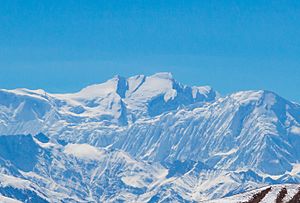American Women's Himalayan Expedition facts for kids
The American Women's Himalayan Expedition was a special trip in 1978. It was the first time women, and Americans, reached the top of Annapurna mountain. This huge mountain is part of the Himalayas. The expedition was led by Arlene Blum. There were thirteen women climbers and six Sherpas. Sherpas are people from Nepal who are very skilled at climbing mountains.
On October 15, the first team reached the summit. This team included Vera Komarkova, Irene Beardsley, Mingma Tshering Sherpa, and Chewang Ringjin Sherpa. They climbed Annapurna using a path called the Dutch Route. Sadly, the second summit team, Alison Chadwick-Onyszkiewicz and Vera Watson, died during their climb.
Contents
Planning the Climb
Arlene Blum and Alison Chadwick-Onyszkiewicz first thought of an all-women expedition in 1972. Arlene had been turned down from big climbing trips before because she was a woman. She said that few American women got the chance to climb very high. She also noted that no American woman had climbed above 8,000 meters. Only seven women from other countries had done so.
Arlene hoped this trip would give many women important experience. This would help them join other expeditions or start their own. The team, led by Blum, went through special mental tests. They also followed individual training plans. In the 1970s, many climbers wanted to try new ways of climbing. They didn't want to use the old "military style" methods. As the first all-female team, these women wanted to create their own leadership styles. They wanted to be different from the male-led expeditions before them.
Getting Money for the Trip
The team spent a whole year raising money for their climb. They mostly sold T-shirts with a catchy slogan: A Woman’s Place is on Top. They also got help from the American Alpine Club. Other supporters included the National Geographic Society, Johnson & Johnson, and OB Tampons.
The Expedition Begins
At that time, only eight people had climbed Annapurna. They had used three different routes. Annapurna is now known as one of the most dangerous mountains in the Himalayas. About 32% of climbers who try to reach the top do not make it back. The mountain has many avalanches, which are sudden slides of snow. Climbers didn't fully understand this danger back then.
The team used a "siege style" approach to the mountain. This means they set up many camps along the way. They left Pokhara with over 12,000 pounds (5,400 kg) of supplies. A team of porters helped carry everything. There were 13 women climbers and 6 Sherpas. Arlene Blum had hoped to hire female porters for lower parts of the mountain. She also wanted to train them to be climbers. But she faced problems with the Sherpas' union. The women hired were also not strong enough to carry heavy loads.
The team reached base camp on August 26. From there, they moved up a ridge towards the north to set up Camp 2. They had to choose between two routes. One was called The Dutch Rib, which was direct and harder. The other was a new part of the Spanish Route, which looked easier. They chose The Dutch Rib after seeing several avalanches on the Spanish Route.
They waited for a special prayer-flag ceremony to open the mountain. Then, on September 12, they started climbing towards Camp 3. On September 19, Komarkova and Chewang had to go back to base camp. This was because of many avalanches.
On September 27, Chadwick-Onyszkiewicz, Liz Klobusicky-Mailänder, Chewang, and Lakpa set up Camp 3. Another near-avalanche made the ridge safer to climb. On the same day, an avalanche slid 3 kilometers down to Camp 1. The strong wind from it flattened tents.
By October 8, they had reached Camp 4. They planned to set up one more camp before trying for the summit.
Reaching the Summit
At first, Arlene Blum wanted the first summit team to have three women and no Sherpas. She wanted Sherpas to join the second team. But Komarkova wanted Sherpas Mingma and Chewang to join them. In the end, the first summit team included Komarkova, Irene Beardsley, Mingma Tsering Sherpa, and Chewang Ringjin Sherpa. Piro Kramer, an eye surgeon, had to turn back. This was because he got a frostbitten finger. The team successfully reached the top on October 15.
Chadwick-Onyszkiewicz and Vera Watson really wanted to try for a second summit. They wanted a large team. However, many other climbers were sick, had frostbite, or were very tired. They couldn't convince another climber, Whitehouse, to join them. Whitehouse thought their judgment might not be good. But Chadwick-Onyszkiewicz and Watson decided to continue anyway. Wangyel went with them to Camp 5. They planned to climb the central peak of Annapurna I Central, which had not been climbed before.
Sadly, Wangyel got sick and went back down. This left the two women without support. They missed a planned radio call. Three days later, Lhakpa Norbu and Mingma found their bodies below Camp 4.
Why This Expedition Was Important
Early news reports, like those in the New York Times, said the climb was an inspiration for women. They noted that women's mountaineering in America had "come of age." It was also important for women's rights movements at the time. Arlene Blum's book about the trip, Annapurna: A Woman's Place, inspired many later climbers. One famous climber, Kitty Calhoun, said it was a big influence.
At the time, some men, including David Roberts, criticized the expedition. They said the Sherpas helped too much on an all-women's trip. They also questioned the decisions that led to the deaths of Chadwick-Onyszkiewicz and Watson. Arlene Blum said this criticism was unfair. She pointed out that no one complained when Sherpas helped on all-male expeditions. She also noted that, at the time, about one climber had died for every person who reached Annapurna's summit.


